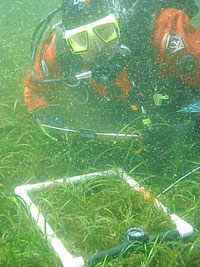Pacific Herring
(Clupea pallasii)
Research

Historically, ADF&G has conducted two direct observational methods for estimating herring biomass in Southeast Alaska: (1) egg deposition dive surveys, and (2) vessel hydroacoustic surveys. In cases where egg deposition surveys are used, the biomass estimate is based on data only from mature herring that spawned that season. Acoustic surveys have not been used to estimate biomass since the 1993/94 season, because the method is thought to be less reliable than egg deposition estimation.
Herring stock assessment activities begin in the spring with aerial and foot surveys conducted by department staff. Herring spawning activity is documented during these surveys and used to determine, among other things, where to distribute SCUBA dive transects. The dive transects are used to derive egg deposition estimates which are used along with many other biological parameters, including age and growth, to estimate spawning biomass. Age and growth information are obtained by samples collected from test fishing, commercial harvests, mid-water trawling, and sampling on the spawning grounds by the department.
Forecasts for herring in Southeast Alaska are currently computed using either an Age-Structured Analysis (ASA) or a biomass accounting method where the observed spawning biomass and age composition from one year is modified by estimates of growth and mortality to produce a forecast for the subsequent year’s biomass.
